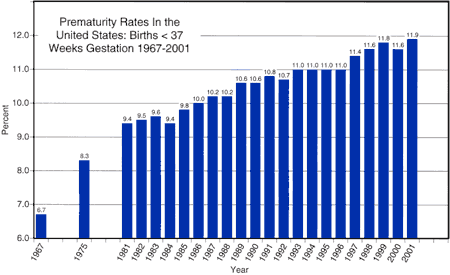The prematurity rate in the United States is a national tragedy! While the American College of Obstetricians and Gynecologists says the incidence of preterm birth has “changed little over the last 40 years,” it actually has increased from 6.7 percent in 1967 to 12.1 percent in 2002. It represents the leading cause of neonatal mortality and the second leading cause of infant mortality (death during the first year of life). And, for the first time since 1958, there has been an increase in the infant mortality rate between 2001 and 2002. The increase was concentrated in the neonatal period. The increasing prematurity rate is documented over a 35-year period of time in Figure 1-17.

A prematurity prevention program has been developed and implemented at the Pope Paul VI Institute for the last 25 years. The program begins by identifying those patients who are at high risk for going into preterm labor. These patients are then taught how to self-monitor their uterine contractions. When indicated, supplemental intramuscular progesterone is provided while monitoring serum progesterone levels and tocolytic therapy (usually with Terbutaline) is used for symptoms of uterine irritability (contractions).
In addition to the above, antibiotic therapy is provided to those patients who break through their tocolytic therapy. Ultrasound assessment of the cervix is also used according to risk criterion, symptoms or pregnancy condition. If ultrasound assessment of the cervix indicates, cervical cerclage is placed.
This entire protocol cannot be properly discussed in a web site such as this, however, it can be stated emphatically that the prematurity rate can be decreased with the use of this protocol. The summary of delivery rates using the Pope Paul VI Institute Prematurity Prevention Program and comparing it to a comparison group is shown in Table 56-26 for the various gestational ages. For the entire group, the comparison group had a preterm birth rate of 12.0 percent and the Pope Paul VI Institute group protocol only had a 7.0 percent prematurity rate and in that group, only 1.3 percent were at < to 33.9 weeks of gestation. This is three times less than the comparison group.
Once again, the entire system for the prevention of preterm labor cannot be adequately presented with this short presentation. However, one is referred to the Medical and Surgical NaProTECHNOLOGY for a complete and thorough discussion of it.
